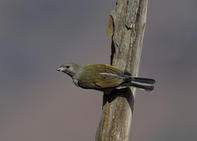
Name
Lesser honeyguide - Indicator minor
Lesser Honeyguide Appearance
The lesser honeyguide is around 15 cm in length. The lesser honeyguide has dark grey upperparts and lighter underparts, with a black malar stripe. The back and wings are olive green. The sexes are alike.
Diet
The lesser honeyguide feeds mainly on beeswax and will feed on the other contents of a bee colony, bee eggs, bee larvae, bee pupae and bees. This honeyguide will eat other insects.
Honeyguides are one of the few birds that can digest wax.
Like all honeyguides, the lesser honeyguide will feed at an active bee’s nest in the early morning when the bees are lethargic. It will readily feed at abandoned hives and hives that have been disturbed or robbed by humans or other animals.
Lesser Honeyguide Breeding
The lesser honeyguide is a polygynous brood parasite that parasites a range of hole nest species. The main hosts are barbets but they will also lay their eggs in bee-eaters, kingfishers and starling nests. When laying in a host’s nest, the lesser honeyguide female will commonly break the host's eggs. When hatching, the honeyguide chick has a hook on its bill to kill any of the host's chicks, that are hatching at the same time.
Lesser Honeyguide Behaviour
The lesser honeyguide has a monotonous call with a single note that is repeated every second, for up to 40 times from a song post. The same song post will be used for repeated seasons.
Threats
None.
Lesser Honeyguide Distribution and Habitat
The lesser honeyguide Is found in woodland and riverine forest in the eastern and northeastern areas of South Africa.